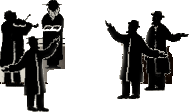During the Thaw, the authorities did not intervene as much in the internal life of religious communities, including the Jewish community. However, it was still officially forbidden to carry out prayer meetings in private apartments. Nevertheless, now, when the militia (Russian police) invaded an apartment during prayer, Jews even dared to protest and to express their indignation at the militia's action. In winter, some constant illegal minyans operated in the city; in summer, their number increased. Leningrad Jews traditionally chose the same suburban locations for summer rest. Many generations of Jews who did not follow religious traditions rented holiday cottages in Sestroretsk or Lisiy Nos; and religious followers - in Vsevolozhsk or Melnichniy Ruchey. Those suburbs are situated on the Karelian Isthmus 20-30 km from Leningrad.
Sometimes, religious Jews could buy kosher meat. Shoykhet (slaughterer) Reb Mordekhay Razran selected the cattle for shehitah and after slaughtering, if the meat was deemed kosher, he let all those who wished to buy it know the hour when it would be sold. All those who bought kosher meat knew that it would be sold at Sennoy Market. The seller of kosher meat was Reb Shlomo Bolotovsky. In summer, one of the minyans gathered in his house in Vsevolozhsk. Religious feasts were celebrated at home. Shortly before Pesach, even matzoth was baked in private kitchens. For some years, it was possible to buy matzoth at the city's bakeries. Jews took their place in queues the night before. In the late 1950s, foreigners who came to Leningrad as tourists or on business began visiting the Synagogue. Such visitors were especially numerous during International Fur Auctions.
In the late 1960s, Preobrazhenskoye Cemetery was closed for new burials. The space allotted for Jewish graves at the Cemetery of the Memory of the January 9 Victims was very limited. Jews were compelled to bury their dead at various city cemeteries. By 1962, the Lengorispolkom decided to open the new North Cemetery in Pargolovo. Lenproyekt designed the cemetery; the head of the design team was N.N. Fonton. Member of LERO L.M. Zeilikson worked as chief expert in communications at Lenproyekt. It was he who talked N.N. Fonton into allotting a special Jewish area for the cemetery. The community appointed young architect G.A. Izrailevich to develop the design and he carried it out in accordance with all the ritual requirements. Deputy Chief Architect of Leningrad I.I. Fomin approved the design. They convinced N.N. Fonton that the community would pay her and Izrailevich 500 rubles each and that the authorities would allow the construction.
It seemed that no obstacles remained. However, when the community discussed the design, they found they had no money for the project. Hopes for assistance from American Jews proved unfounded. The head of the Building Department of GlavAPU Golverk finally killed the project. Perhaps, he was afraid of being accused of Jewish nationalism; he said he would not allow the construction of a memorial to "Katzmanouts". It sometimes seemed that the persecution was coming to an end. The reason for the hopes was the fact that performances of Jewish poetry and music were allowed sometimes. So, in the summer of 1966, a performance by Israel singer Iula Gili took place in the Rest Garden Theater; the performance created excitement among all Leningrad Jews. In December of the same year, in the Concert Hall, a Jewish Poetry evening took place. Works by the rehabilitated L. Kvitko and by other Jewish poets were recited there. Then again, the evening closed with "Soviet Passport" by V. Mayakovsky, which had nothing to do with anything Jewish. In 1964, all public appearances by Nekhama Lifshitsaite were forbidden when she appealed for permission to leave for Israel.
The persecution of Jewish culture was combined with obstacles against the education of Jews in the arts. Party functionaries were especially afraid lest the successors of centuries-old Jewish culture continue academic research. That is why Jews were not admitted for study in the Semitic Section of Oriental Faculty of Leningrad State University from the late 1940s until the late 1980s. Jewish professors in that sub-faculty were barely tolerated. The fate of two outstanding oriental studies scholars, I.D. Amusin and I.Sh. Shifman, may be regarded as typical. Although they were founders of original approaches in oriental studies, they could not devote themselves to Semitology.
By the mid-1950s, the efforts of Party ideologists and the police force seemed to bear fruit. Fewer Jews attended synagogue. Some were in their declining years; some were afraid to engage in religious activity for fear of harming their children and grand-children. Even on the holiday of Simkhat Torah, the Synagogue was almost empty. However, this situation continued for only a few years. Jewish young people suffered constant discrimination in education and employment, even though their rights were theoretically guaranteed by the Constitution. They began to realize not only the injustice of Soviet reality, but also the necessity of change. First, they began seeking out like-minded persons. By the late 1950s, much more young people gathered in the Synagogue on Simhath Torah. The authorities had to send groups of militiamen and volunteers to Lermontovsky Avenue. Ominous "black ravens" barred the avenue near the Synagogue.
KGB officers mixed with the crowd in the Synagogue yard and made lists of the students. Those students were then excluded from the Komsomol and university. The situation reached the point where university Partkoms ordered Jewish professors to carry out explanatory work among their students on the eve of Simkhat Torah. But all of these measures failed to stop the growing interest of Jewish youth in their traditions. They also attended the feast to make acquaintances or experience a Jewish atmosphere. Nobody knows how many Jewish marriages resulted from those autumn feasts, although they were certainly numerous. In the same place, in the Synagogue yard, those whose interest was not only to attend a holiday found like-minded friends. This way, those who liked to study Hebrew, Jewish history or who wanted to emigrate established the necessary contacts.
Gradually, some groups of Jewish young people went over to more serious activity. They obtained the manuals (however difficult it was in those years) to began studying Hebrew; they copied and propagated the texts of Voice of Israel broadcasts. The most desperate ones appealed for the permission to emigrate to Israel. In the autumn of 1966, two Leningrad Jewish groups united into a Zionist organization which declared its purposes: to struggle for free exit from the USSR for Israel; and to awaken nationalism among Soviet Jews, first of all young people, by means of propagating Jewish culture. They set up links with similar organizations in Riga and Kishinev. Members of the organization appealed for permission to emigrate to Israel and got refusals. In the autumn of 1969, they began getting ready to escape from USSR to Sweden to go from there to Israel. The operation had the code name Wedding.












![]()
![]()
![]()
![]()
![]()
![]()









